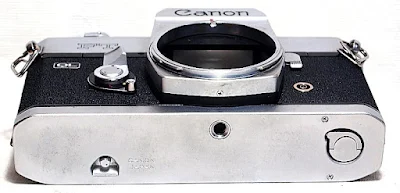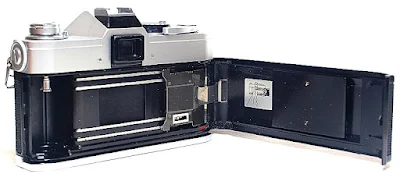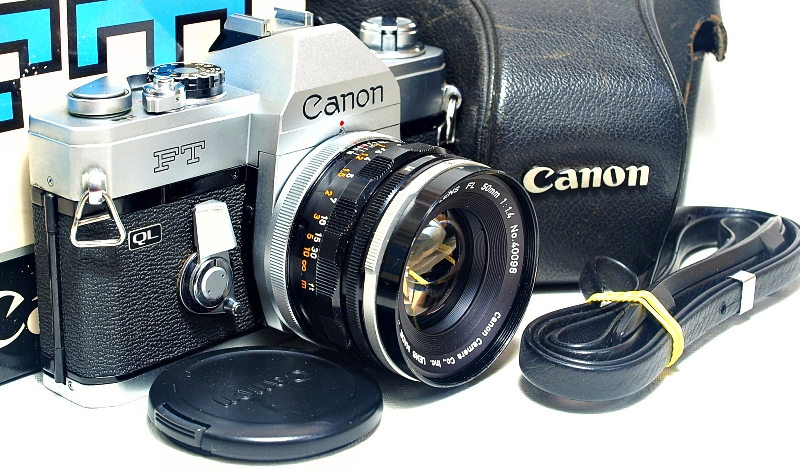The Vintage Enthusiast: A look back at a robust and easy-to-use manual focus and manual exposure 35mm SLR film from Canon.
The Canon FT QL, a manual focus, and manual exposure 35mm SLR film camera, was launched by Canon in 1966, a year after the pellicle mirrored Canon Pellix. Different from the Pellix, the FT QL has a normal quick return reflex mirror and a semi-spot stop-down TTL metering system that works through a condenser system incorporated in the viewfinder screen assembly, much like the system found on later Canon F-1s.
The camera comes fitted with the Canon FL mount system which is adaptable to the wide range of FL series lenses that were available, and later FD series lenses in stop-down mode. With the mirror locked up, the FT QL can be used for vibration-free shots or for use with special FL lenses. The original Canon 19mm F3.5 wide-angle, which has a backend that projects deep into the camera body, is an example.
Operationally, the FTb QL has an all-mechanical horizontally traveling cloth focal-plane shutter with a shutter speed range from 1 to 1/1000 second, Bulb, and an 8-10 second delay self-timer. Flash synchronization is at 1/60 second, and the camera accepts film ISO speeds ranging from 25 to 2000. Depth of field preview is via the same lever that operates stop-down metering on the front plane of the camera body.
Stop-down exposure reading, with a match-needle viewfinder readout, is off-the-ground glass Fresnel with a center spot microprism, which is the 12% central rectangular area of the screen. The FT QL can also be fitted with the Canon Booster, an auxiliary meter, for measuring exposures of subjects in low-light conditions.
Basic Camera Features
On the development side, the FT QL was a cumulation of three previous models of the same series that were introduced previously. They were the Canon FX which had a built-in meter but no through-the-lens (TTL) metering, the entry-level Canon FP which was built without a built-in meter, and the FT.
The QL badge is the identifier to Canon's 'quick load' system, a spring-hinged device inside the rear door to make film loading easy and simple. The FT QL was improved with internal upgrades to its components and cosmetics over its production run, which ended in 1972 when it was superseded by the Canon FTb QL.
The front plane of the FT QL is rather a plain sight, with the Self-Timer/Stopped Down Metering/Metering Lever Lock combination mechanism to the left of the lens mount housing, and on the lower right, the Flash Sync Socket, with the Mirror Lockup Lever above it.
From the top, on the far left of the top plane is the Film Rewind Crank and the Battery Check Lever assembly, the pentaprism hump, and Accessory Shoe, while on the right of the top plane is the Shutter Speed Dial integrated with the pull-up and turn film ISO Speed Selector, Shutter Release Button cupped by Time Lock and Safety Lock Lever, film Frame Counter, and Film Advance Lever.
On the backplane is the Viewfinder Eyepiece located on the back of the top plate, while the rest of the backplane of the camera is occupied by the plain hinged Film Back. The battery chamber and its screw cover, not seen on other SLR film cameras are on the left shoulder of the top plate, a very convenient design if you have an autowinder or a motor drive attached to the bottom plate of the camera. The FT QL, however, is not designed for such an attachment
On the bottom plane is the Tripod Socket, the Rewind Release button, and the one-third turn key to open the Film Back. This is different from what you might find on later SLR film camera designs where the Film Back release latch is integrated as a pull-up of the Film Rewind Crank.
The film box, almost the standard configuration as you might find with other SLR film cameras, is fitted with the spring-loaded 'QL' mechanism over the film take-up spool area.
Film Loading and Rewind
As an indication that the film is properly loaded, you will notice that the Film Rewind Crank rotates as you wind the Film Advance Lever. If the rotation is not apparent, the film might have not loaded properly. To rectify the system, open the camera back and repeat the film loading sequence.
To rewind, press the film rewind release button located on the bottom plane of the camera, flip the rewind crank out, and crank in the clockwise direction until the film is completely wound back into its canister before taking the canister out and sent for processing.
Viewfinder Readout
Matching the meter needle to align the aperture needle, while measuring the exposure in stop-down mode, is all that it takes to set the image to its correct exposure.
Stop-Down Exposure Measurement
For exposure measurements, once the film is properly cranked and the image framed, press the Metering Lever inward, i.e. towards the lens mount housing, and do the needle matching by adjusting the aperture opening of the lens for shooting in Shutter Priority Mode, or by adjusting the Shutter Speed dial for shooting in Aperture Priority mode.
Release the shutter once you are happy with the setting.
A good help if you are shooting in Aperture Priority mode, i.e. when you have to use the Shutter Speed dial to adjust for the correct exposure, is to set the Metering Lever locked. Do this by pulling the Metering Lever Lock outward once the Metering Lever is set.
Self-Timer
Set the Self-Timer on the FT QL by rotating the Self-Timer lever counterclockwise until it stops, and activate it by releasing the shutter. The timer is designed for a delay of approximately 10 seconds.
Mirror Lockup
Mirror lockup on the FT QL is activated by rotating the Mirror Lockup Lever to the horizontal position. The mirror will stay locked until the lever is pushed back to its vertical position.
Multiple Exposure
Multiple exposures on the FT QL are done the old-school way. First, tension the film firmly by turning the Film Rewind Crank clockwise until it firms, next press the Rewind Release button, and do a proper rewind of the film to the width of 1 frame by doing a 3/4 (270 degree) turn on the Film Rewind Crank.
Next, crank the film forward again with the Film Advance lever to bring forward the previously framed to align with the shutter window and to activate the shutter release. You are now set to go.
Battery
The FT QL is designed to be powered by a 1.35V PX625-type mercury cell. While these batteries are obsolete, they can be replaced by the Wein zinc-air cell PX625, or hearing aid batteries. Alternative options include using 1.5V cell buttons through a voltage-dropping adapter or recalibrating the meter on the camera.
Battery Check
To run the Battery Check, first set the film ISO speed to ASA 100, and Shutter Speed to 'X', next press the Battery Check lever on the lower part of the Film Rewind Crank to 'C', and observe the viewfinder readout. The meter needle should swing into the exposure index area if the battery has sufficient power, or be replaced if the needle stays below the exposure index area.
Lens Compatibility
The camera is compatible with all breach-lock Canon FL lenses in stopped-down metering mode, and also with later FS-series lenses, again used in stopped-down metering mode. Earlier R-series lenses have a different lens aperture mechanism and cannot be used on the FT QL.
Camera Body Weight
The FT QL body weight is only 740 grams body only.
Click on the link to download the PDF version of Canon FT QL Instruction from Buktus.org.






















No comments:
Post a Comment